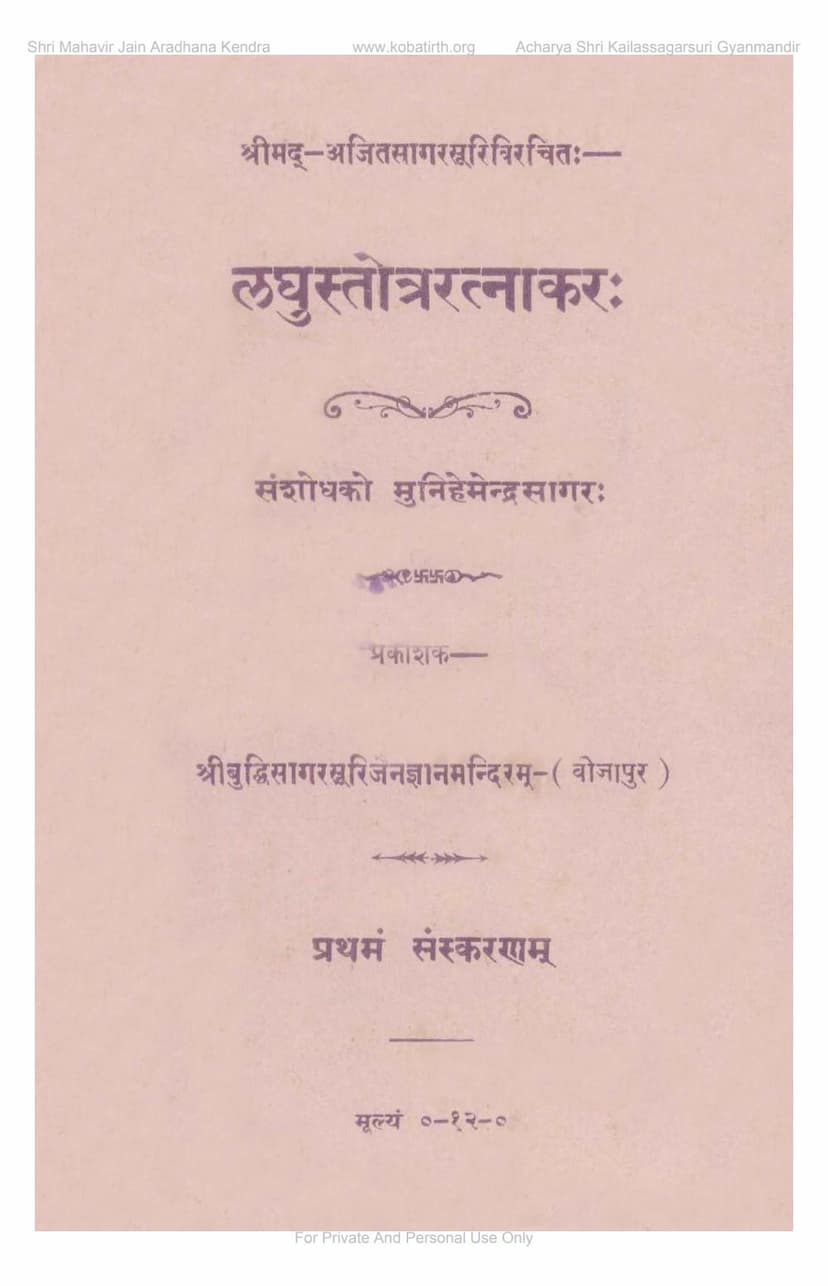Laghustotra Ratnakar
Added to library: September 2, 2025

Summary
Here's a comprehensive summary of the Jain text "Laghustotra Ratnakar" based on the provided pages, focusing on its content, purpose, and the biographical details of its key figures:
Book Title: Laghustotra Ratnakar (लघुस्तोत्ररत्नाकरः) Author: Shrimad Ajitsagar Suri (श्रीमद्-अजितसागरसूरिविरचितः) Compiler/Editor: Muni Hemendrasagar (संशोधको मुनिहेमेन्द्र सागरः) Publisher: Shri Buddhisagar Suri Jain Gyanmandir, Bijapur (Gujarat) (प्रकाशक श्रीबुद्धिसागरसूरिजनज्ञानमन्दिरम्-( वोजापुर ))
Overall Purpose and Content:
"Laghustotra Ratnakar" translates to "A Collection of Minor Jewel-like Stotras (hymns/prayers)". This text is a compilation of various stotras, hymns, and devotional verses, primarily authored by Jain Acharyas. The purpose of this collection is to provide devotional material for Jain practitioners to aid in their spiritual progress, contemplation, and veneration of Tirthankaras and other revered figures. The book contains a wide array of devotional compositions, including:
- Stotras by Ajitsagar Suri: The primary author, Ajitsagar Suri, has contributed his own stotras, astakas (eight-verse compositions), and descriptive verses on various subjects.
- Stotras by Ancient Acharyas: The compilation also includes significant works by earlier revered Jain acharyas.
- Mantra-infused Stotras: Several stotras are noted to be infused with mantras, indicating their use in more focused devotional practices.
- Diverse Devotional Themes: The stotras cover a range of themes, including praise of Tirthankaras, veneration of specific deities (like Padmavati, Saraswati, Ghantakarna Vir), descriptions of sacred places (like Arbuda-Aboo), and expressions of detachment (Vairagya).
- Biographical Information: The text includes a detailed account of the life of Acharya Ajitsagar Suri, offering insights into his spiritual journey, intellectual prowess, and contributions to Jain literature and philosophy.
Key Figures:
-
Acharya Ajitsagar Suri (The Author):
- Early Life: Born in the village of Narsar (नरसमूह) in a prosperous Vaishya family, his parents were Lallubhai and Sonbai. He was characterized by a pious nature, devotion to God, and auspicious signs from birth.
- Intellectual Prowess: He quickly mastered the Gujarati language and possessed exceptional oratorical skills and sharp intellect.
- Spiritual Awakening: After the passing of his parents, he contemplated the transient nature of worldly existence and the prevalence of suffering. This led him to seek spiritual refuge.
- Initial Renunciation: He took diksha (initiation) from the Sthanakvasi ascetics, receiving the name Amibhrishi (अमीऋषि). He traveled extensively, preaching and enlightening people in various regions of India.
- Dispute with Sthanakvasi Views: Amibhrishi studied various Jain scriptures and texts. He developed significant disagreements with the Sthanakvasi sect's rejection of idol worship, which he believed was contrary to the ancient Jain tradition and the explicit pronouncements in Tattvartha Sutra and other scriptures. He found their practices to be misleading to the masses.
- Acceptance of Shvetambara Sect: After extensive study and correspondence with Acharya Buddhisagar Surishwar, Amibhrishi accepted initiation into the Shvetambara tradition, taking the name Ajitsagar (अजितसागर). He approached all religious views with tolerance.
- Scholarly and Literary Contributions: Ajitsagar Suri deeply studied Sanskrit and Prakrit literature, gaining profound knowledge of Agama (Jain scriptures). He was a prolific writer, composing numerous works in Sanskrit and Prakrit, including philosophical treatises, commentaries on Mahakavyas, and devotional hymns. His works are described as beautiful, accessible, and filled with rasa (aesthetic sentiment). He also translated some ancient texts into local languages.
- Guru and Acharya: He received the titles of Punyasagar and Ganiprada from Acharya Viravijay. He was later honored with the title of Acharya and placed in charge of the Sagar Sanghataka by Acharya Buddhisagar Surishwar himself.
- Social and Religious Impact: Acharya Ajitsagar Suri was a spiritual leader and social reformer. He delivered sermons that benefited society, supported religious institutions and gurukuls, and even engaged in interfaith dialogues. He actively promoted ahimsa (non-violence) and propagated Jain principles across various regions.
- Discipleship and Legacy: He mentored and initiated many disciples, including Muni Rishisagar and Muni Kirtisagar, and appointed them to positions of responsibility.
- Passing: He attained liberation (moksha) in V.S. 1991 (Vikram Samvat).
-
Muni Hemendrasagar (The Compiler/Editor):
- Muni Hemendrasagar is credited with the meticulous compilation and editing of this work. The "Nivedan" (Preface) highlights that the publication of this book was a significant undertaking, and Muni Hemendrasagar's efforts were crucial in its completion. He is acknowledged for his guidance and diligence, ensuring the book's accuracy and accessibility for readers.
-
Acharya Buddhisagar Suri (The Inspiration and Guiding Force):
- Acharya Buddhisagar Suri was the guru of Ajitsagar Suri. His teachings and spiritual guidance were instrumental in Ajitsagar Suri's journey, particularly in resolving theological differences and solidifying his path within the Shvetambara tradition. The publisher, "Shri Buddhisagar Suri Jain Gyanmandir," is named in his honor.
Structure and Significance:
- The "Nivedan" and "Prastavana" sections provide introductory remarks from the publisher and the editor, respectively, explaining the book's purpose, content, and the significance of the stotras.
- The "Shuddhipatra" (Errata) indicates the meticulousness of the editing process, correcting any printing errors.
- The biographical sketch of Ajitsagar Suri is a significant part of the introductory material, establishing his credentials and the importance of his contributions.
- The subsequent pages are filled with various stotras, devotional poems, and hymns, covering a vast range of Tirthankaras and other sacred subjects. The table of contents (vishayānukramaḥ) at the end of the digitized pages lists these compositions extensively.
Overall Impression:
"Laghustotra Ratnakar" is a valuable resource for Jain devotees, offering a rich collection of devotional literature compiled and edited by learned scholars. It highlights the spiritual depth and literary contributions of Acharya Ajitsagar Suri and provides a glimpse into the devotional practices and philosophical underpinnings of Jainism. The book serves as a testament to the rich tradition of hymnology and spiritual instruction within the Jain faith.